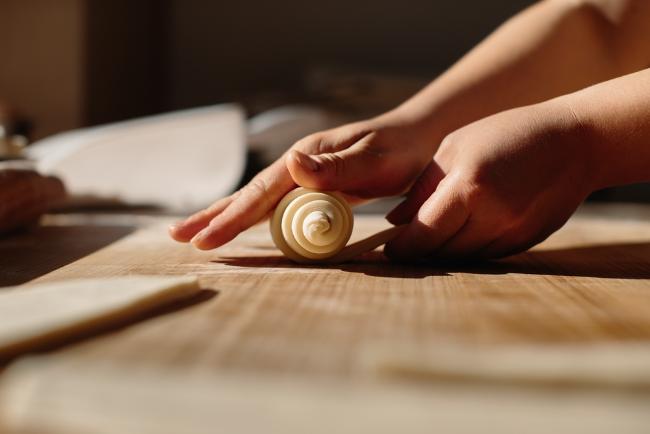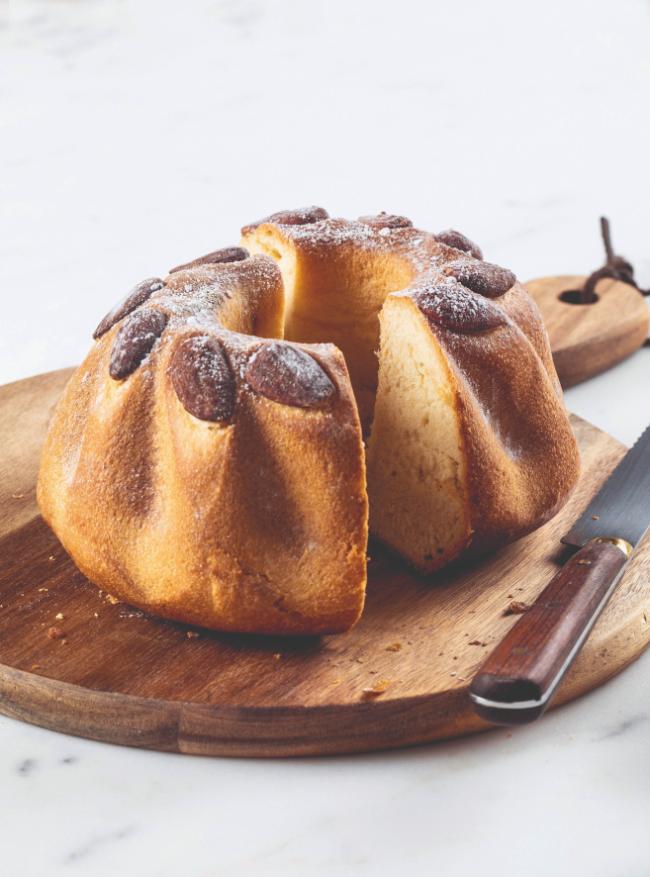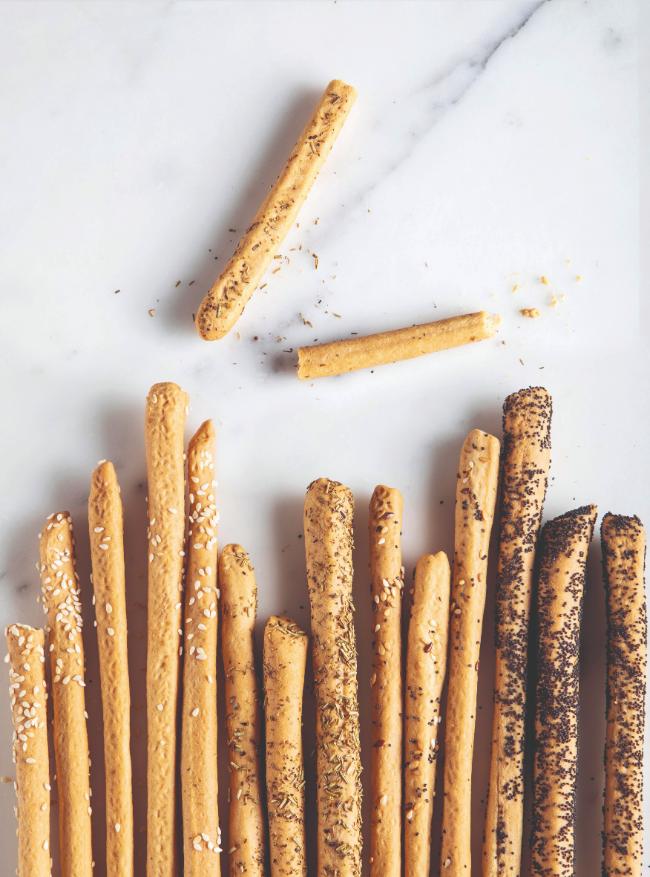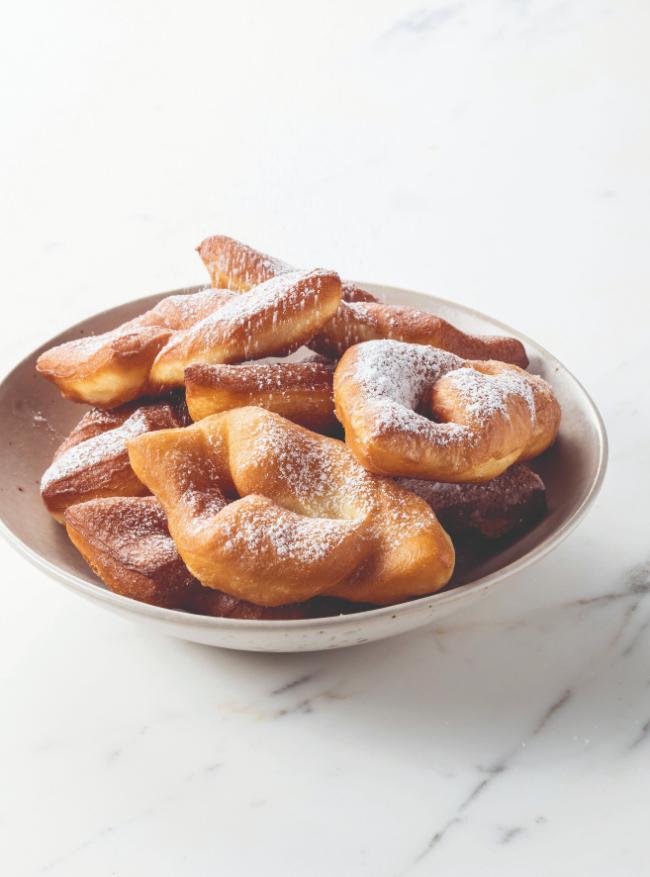Traditional French Bakes from the Ferrandi School

The latest in the series of books from the Ferrandi School of Culinary Arts explores the French art of baking. Here we present four delicious recipes to try at home.
Kougelhopf Kouglof
Makes 2 kougelhopfs to serve 6-8 | Active time: 1 hour 1Pre-ferment fermentation time: 3 hours | Bulk fermentation time: | hour + overnight in the refrigerator | Chilling time: 30 minutes | Proofing time:
1½ hours | Cooking time: 30-35 minutes | Storage: Up to 2 days
EQUIPMENT
- Stand mixer + dough hook
- Instant-read thermometer
- 2 x 8 in (20 cm) silicone kougelhopf moulds
INGREDIENTS
Pre-ferment
- ¼ cup + 2 tbsp (3.5 oz/100 g) all-purpose flour (T55)
- ¼ cup (60 g/60 ml) whole milk, well chilled 0.25 oz (8 g) fresh yeast, crumbled
Kougelhopf dough
Pre-ferment (see above)
- 3½ cups (14 oz/400 g) all-purpose flour (T55)
- Scant ½ cup (3.5 oz/100 g) lightly beaten egg (2 eggs)
- ½ cup minus 1 tbsp (110g/110 ml) whole milk
- 0.5 oz (12 g) fresh yeast
- 2 tsp (10 g) salt
- 20 7 tbsp (3.5 oz/100 g) butter, diced, at room temperature
- 1½ cup minus 1½ tbsp (2.75 oz/80 g) sugar
To bake and serve
- Butter for the moulds
- 2 tbsp (20 g) whole almonds Confectioners’ sugar
METHOD
Preparing the pre-ferment (1 day ahead)
1. Whisk together the flour, milk, and yeast in a bowl until smooth. Cover with plastic wrap and let ferment for 3 hours at room temperature.
Preparing the kougelhopf dough (1 day ahead)
2. Knead all the dough ingredients, except the butter and sugar, in the bowl of the stand mixer on low speed for 5 minutes until well combined. Increase the speed to medium and knead for 6-8 minutes until the dough is supple and elastic. With the mixer running on medium speed, add the butter and sugar and knead until completely incorporated (6-8 minutes). Make sure the dough temperature does not exceed 75°F (24°C). Place in a clean bowl, cover with plastic wrap, and let ferment for I hour at room temperature. Fold the dough once, retum it to the bowl, and cover with plastic wrap. Let rest in the refrigerator overnight.
Shaping and proofing the kougelhopfs
3. The next day, divide the dough into 2 pieces. Shape into balls and chill for 30 minutes. Grease the moulds with a little butter and arrange the almonds around the base of each, placing them in the grooves. Shape each dough ball into a small ring by making a hole in the centre. Transfer the dough to the moulds, taking care not to displace the almonds. Let proof in a steam oven set to 75°F (24°C), or place on a rack in a turned-off oven above a bowl of boiling water, for about 1 1/2 hours.
Baking the kougelhopfs
4. Preheat the oven to 350°F (180°C/Gas Mark 4) and bake the kougelhopfs for 30-35 minutes. Tum them carefully out of the moulds onto a rack to cool. Once they have cooled completely, dust the tops with confectioners’ sugar.

Kougelhopf, from French Boulangerie, © Rina Nurra
FLAKY ROLLS
Petits pains feuilletés
Makes 16 rolls, weighing about 2 oz (60 g) each | Active time: 2 hours | Bulk fermentation time: 1 hour + 10-12 hours in the refrigerator | Resting time: 1 hour | Proofing time: 1/2 hours | Cooking time: 20 minutes | Storage: Up to 24 hours wrapped in a clean dish towel
EQUIPMENT
- Stand mixer + dough hook
- Instant-read thermometer
- 16 x 2½ in (6.5 cm) round cake pans, 1½ in. (3.5 cm) deep
INGREDIENTS
- Water dough
- 4 cups + 2 tbsp (1 lb. 2 oz/500 g) all-purpose flour
- 1 cup + 5 tsp (270 g/270 ml) water
- 1½ tsp (9 g) salt
- 0.25 oz (5 g) fresh yeast
LAMINATING BUTTER
- 1 stick + 2 tbsp (5 oz/150 g) butter, preferably 84% fat Butter for the pans
- To finish
- 3 tbsp (1.75 oz/50 g) butter, browned Fleur de sel
METHOD
Preparing the water dough (1 day ahead)
1. Knead all the water dough ingredients in the bowl of the stand mixer on low speed for 5 minutes until well combined. Increase the speed to medium and knead for 5 minutes until the dough is supple and elastic. Make sure the dough temperature does not exceed 75°F (24°C). Place in a clean bowl, cover with plastic wrap, and let ferment for 1 hour at room temperature. Fold the dough once, shape it into a ball, and place in a clean bowl. Cover with plastic wrap and let ferment for 10-12 hours in the refrigerator.
Laminating the dough
2. The next day, roll the dough into a 6 x 12 in (15 x 30 cm) rectangle. Roll the laminating (84%) butter into a 6 in (15 cm) square. Place the butter in the centre of the dough and fold the ends of the dough over it to meet in the centre, enclosing the butter completely. Roll the dough into an approximate 8 x 20 in (20 x 50 cm) rectangle. Fold the shorter ends of the dough over so that they meet in the centre, then fold the dough in half, like a book, to make a double turn. Let rest for 15-30 minutes in the refrigerator: Give the dough a quarter turn clockwise. Roll the dough into an approximate 8 x 20 in (20 x 50 cm) rectangle, then fold it in 3, like a letter, to make a single turn. Let rest for 30 minutes in the refrigerator.
Shaping and proofing the dough
3. Lightly grease the cake pans with butter and place on a baking sheet. Roll the dough into a 12½ x 21½ in. (32 x 40 cm) rectangle and trim the edges all around. Roll the dough up from one long side into a tight log, then cut the log into 16x I in (2.5 cm) slices. Place the slices flat in the pans. Let proof in a steam oven set to 75°F (24°C), or on a rack in a turned-off oven above a bowl of boiling water, for 1½ hours.
Baking the flaky rolls
4. Preheat the oven to 450°F (230°C/Gas Mark 8) and bake the rolls for 20 minutes until puffed and golden. As soon as the rolls are removed from the oven, brush them with browned butter and sprinkle with a little fleur de sel. Let cool in the pans for 10 minutes before turning them out onto a rack to cool.

Flaky Rolls, from French Boulangerie, Flammarion, ©Rina Nurra
BREADSTICKS
Gressins
Makes about 20 Active time: 1/2 hours | Bulk fermentation time: 30 minutes | Proofing time: 30 minutes | Cooking time: 30-35 minutes | Storage: Up to several days in an airtight container
EQUIPMENT
- Stand mixer + dough hook
- Instant-read thermometer
INGREDIENTS
- 4 cups + 2 tbsp (1 lb. 2 oz/500 g) white bread flour (T65)
- 2/3 cup (160 g/160 ml) cold water
- 3.5 oz (100 g) ripe liquid levain
- 1/3 cup (75 g/80 ml) olive oil, plus extra for greasing
- 2½ tsp (10 g) sugar
- 0.35 oz (10 g) fresh yeast
- 1½ tsp (9 g) salt
- Suggested toppings
- Sesame seeds, poppy seeds, herbes de Provence, etc.
METHOD
Preparing the dough
1. Knead all the ingredients in the bowl of the stand mixer on low speed for 4 minutes until well combined. Do not overwork the dough (see Chef’s Note): if it strengthens too much, it will be difficult to shape and will shrink while baking. Make sure the dough temperature does not exceed 68°F (20°C). Place in a clean bowl, cover with plastic wrap, and let ferment for 30 minutes at room temperature.
Shaping and proofing the dough
2. Divide the dough into 20 pieces weighing 1.5 oz (40 g) each. Roll each piece into a 16 in (40 cm) log and place on a baking sheet greased with olive oil. Brush the breadsticks with a little water and sprinkle with toppings of your choice. Let proof in a steam oven set to 75°F (24°C), or place on a rack in a turned-off oven above a bowl of boiling water, for about 30 minutes.
Baking the breadsticks
3. Preheat the oven to 300°F (150°C/Gas Mark 2) and bake the breadsticks for 30-35 minutes, until dry. If they are thick, the centre may still be soft, but the outside should be crisp.
Chef’s Note: Avoid overworking the dough, as this can make the breadsticks tough, rather than light and crisp.

Breadsticks, from French Boulangerie, ©Rina Nurra
LYONNAISE FRITTERS
Bugnes
Serves 6 Active time: 1½ hours | Bulk fermentation time: 30 minutes | Freezing time: 1 hour | Proofing time: 30 minutes | Cooking time: 3 minutes per batch of fritters | Storage: 24 hours in an airtight container
EQUIPMENT
- Stand mixer + dough hook
- Instant-read thermometer
- Chef’s knife or pasta cutter
- Deep fryer
INGREDIENTS
- 2 cups (9 oz/250 g) white bread flour (T65)
- 1/3 cup (2.75 oz/75 g) lightly beaten egg (about IB/C egg)
- ¼ cup (60 g/60 ml) whole milk, well chilled
- 2½ tbsp (1 oz/30 g) sugar
- 0.25 oz (5 g) fresh yeast
- 1 tsp (5 g) salt
- 3 tbsp (1.75 oz/50 g) butter, diced, at room temperature
- 2 tsp (10 g/10 ml) orange-flower water
- 2 tsp (10 g/10 ml) amber rum
- Finely grated zest of 1 orange
- Finely grated zest of 1 lemon
- Neutral oil for deep-frying
- Confectioners’ sugar for dusting
METHOD
Preparing the dough
1. Knead all the ingredients, except the butter, orange-flower water, rum, and citrus zests, in the bowl of the stand mixer on low speed until well combined. Increase the speed to high and knead until the dough is supple and elastic. Incorporate the butter on low speed, then increase the speed and continue kneading to maintain a supple texture. Add the remaining ingredients and knead until just combined. Make sure the dough temperature does not exceed 77°F-79°F (25°C-26°C). Place the dough in a clean bowl and cover with plastic wrap or a clean dish towel. Let ferment for 30 minutes at room temperature. Fold the dough gently and lay a piece of plastic wrap over the top. Flatten to a thickness of ¼ in (2 cm) and freeze for 30 minutes. Roll the dough into a 16 in (40 cm) square, about in. (3.5 mm) thick. Freeze for another 30 minutes.
Shaping the fritters
2. Using the chef’s knife or pasta cutter, cut out strips measuring 2% in. (7 cm) in width, then cut the strips into diamond shapes with 1½ in (4 cm) sides. Cut a small diagonal slit in the centre of each diamond and pass a knife tip through the slits to open them up a bit. Place on a lightly floured baking sheet and let proof for about 30 minutes at room temperature in a draft-free place.
Cooking the fritters
3. Heat the oil in the deep fryer to 350°F (180°C). Immerse the fritters in the oil, turning them over once the first side is lightly golden. Drain on paper towel and dust with confectioners’ sugar.
From France Today Magazine

Lyonnaise Fritters, from French Boulangerie, ©Rina Nurra
Lead photo credit : © Shutterstock
Share to: Facebook Twitter LinkedIn Email
More in bakery, baking, ferrandi, French bakes, French food, recipes
Leave a reply
Your email address will not be published. Required fields are marked *



